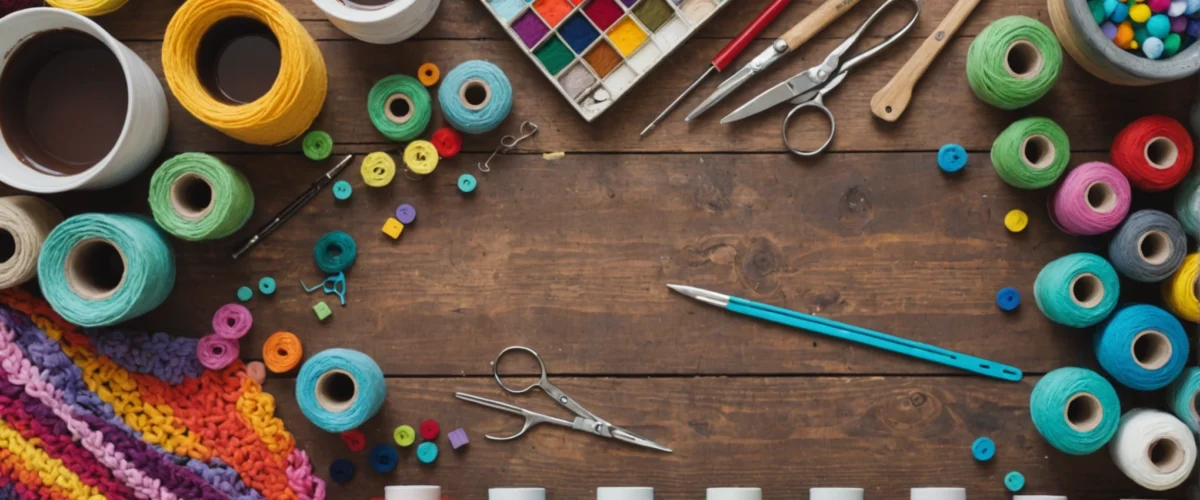Les travaux manuels féminins ont graduellement gagné leur place dans la culture contemporaine. Ce n’est pas simplement une résurgence d’une tradition séculaire, mais une rencontre harmonieuse entre tradition et modernité. Cet article se penche sur l’évolution fascinante de ces pratiques manuelles, leur influence actuelle et la manière dont elles transforment et enrichissent la vie quotidienne des femmes aujourd’hui.
L’histoire et l’évolution des travaux manuels féminins
Les travaux manuels créatifs féminins ont longtemps été ancrés dans des traditions familiales, mais leur essence a évolué au fil du temps. Ils étaient autrefois vus comme une nécessité domestique. Aujourd’hui, ils sont reconnus pour leur valeur artistique et leur capacité à raconter des histoires personnelles et culturelles uniques.
Traditions et savoir-faire transmis de génération en génération
Dans de nombreuses cultures, les activités créatives féminines comme la broderie, la dentelle, le tricot et la couture ont été essentielles à la transmission des savoirs entre générations. Ces techniques exigeaient une compétence méticuleuse et une grande patience, souvent inculquées dès le plus jeune âge. Au delà de leurs fonctions pratiques, ces travaux manuels servaient de symboles d’identité culturelle et de patrimoine familial. Les kits de broderie et les motifs de tricot passaient souvent de main en main, se muant en véritables objets de transmission culturelle.
Les récits oraux liés à ces pratiques, relatés par les femmes dans les foyers, étaient aussi un moyen d’inscrire les expériences féminines dans une histoire plus vaste. En créant chaque pièce – qu’il s’agisse d’un tapis tissé à la main ou d’un vêtement brodé – les femmes ajoutaient leur touche personnelle, exprimant leur identité et leur créativité dans une société souvent restreinte par les rôles traditionnels de genre.
Émergence et reconnaissance des travaux manuels dans l’art moderne
À mesure que la société évoluait, les perceptions sur les travaux manuels ont commencé à changer. Les arts textiles et autres formes de création autrefois classées comme simples « artisanats » ont émergé en tant que disciplines artistiques reconnues à part entière. Les expositions muséales sur l’art textile ont replacé ces œuvres dans le contexte de l’histoire de l’art, reconnaissant non seulement leur esthétique, mais aussi leur rôle subversif dans l’histoire de l’art féminin.
This evolution was not linear, however. In the 20th century, especially with movements like the Arts and Crafts and later the feminist art movement of the 1970s, women artists challenged traditional views on craft and high art. They advocated for these practices as vital expressions of women’s culture and creativity, worthy of recognition and academic study.
Modern techniques and their creative impact
Today, new technology and the accessibility of materials have pushed creative manual activities beyond traditional boundaries.
Recent techniques and materials in crafts
The advent of new materials like polymer clay, as well as digital tools like Cricut, has broadened the horizon for artisans and hobbyists alike. These materials and machines enable an unprecedented degree of precision and variety in crafts, from intricate jewelry to custom apparel. Whether you’re a beginner looking at a DIY project or a seasoned artist looking to expand your inventory, the possibilities are truly endless.
Modern craftspeople can experiment with innovative textures and structures, incorporating mixed media into traditional forms. The synergy between old and new techniques is a driving force for creativity, allowing artists to push boundaries while honoring traditional craftsmanship.
Integration of technologies and digital techniques
The integration of digital technologies into manual crafts has opened new creative avenues. Techniques such as digital embroidery and 3D printing allow for customization and experimentation not possible before. Platforms like Etsy and Amazon now offer extensive resources and creative kits, enabling anyone to start creating or refine their skills. This democratization of craft resources has made creative pursuits accessible to a broader audience, fostering a new community of artisans.
The use of digital platforms extends beyond purchasing supplies. Virtual communities offer courses, tutorials, and inspiration, bridging the gaps between traditional workshops and modern, digital experiences. With just a few clicks, creators can find or share tutorials on new techniques, expanding their skill set and fostering a culture of continuous learning and sharing.
The influence of social networks and online communities
Social media has cemented its role as a critical platform for artists to connect, share, and find inspiration. It’s a dynamic arena where crafts can thrive and evolve.
Online platforms for inspiration and collaboration
Platforms like Pinterest and Instagram have become rich sources of inspiration, offering a window into the diverse world of creative expression. Here, artists can showcase their work and find like-minded individuals, fostering collaborations that cross geographical and cultural boundaries. The exchange of ideas is thriving and continuously evolving, driven by the continual flow of ideas and kits shared among community members.
In these digital spaces, the traditional barriers to entry in the art world are diminished. Creators can gain exposure and build their personal network without needing an agent or gallery representation. These platforms also facilitate direct interaction with audiences and potential customers, leading to more intimate and connected experiences.
Testimonials and successes of female artists
Many female artists have made significant strides by harnessing the power of social media to amplify their voices and showcase their talent. From starting modestly with a personal blog to achieving acclaim on platforms like YouTube, these women embody the intersection of creativity and entrepreneurship. They have managed to carve out niches for themselves, whether by teaching courses, sharing tips, or selling their innovative creations—often directly overcoming the stock shortages that plague traditional retail models.
Among these stories of success are those artists who have also embraced community building, using their platforms to elevate other women and inspire the next generation of creators. Their experiences and lessons reach far beyond the digital realm, influencing real-world practices and expanding what cultural and creative contributions can mean in a modern context.
L’impact des travaux manuels sur le développement personnel et professionnel
S’adonner aux travaux manuels va bien au-delà de la simple création d’objets ; ces activités ont un impact profond sur la croissance personnelle et professionnelle.
Découverte de soi et bien-être par la créativité
Engaging with manual work provides a form of therapy and personal satisfaction that nurtures the soul. Whether sculpting, painting by numbers, or creating handmade decor, these activities allow for self-expression and relaxation in a hectic world. They provide a sanctuary from the everyday hustle, fostering moments of tranquility and introspection.
Through these creative endeavors, individuals often discover new passions, develop patience, and enhance problem-solving skills. Creating something tangible can instill a sense of accomplishment and pride, reinforcing positive self-esteem and promoting mental well-being.
Opportunités économiques et entrepreneuriat féminin
The craft industry offers various economic opportunities for women entrepreneurs. Many have leveraged traditional skills and modern marketing tools to turn their crafting passion into viable businesses. Platforms like Etsy allow for the sale of handmade creations, while others might offer workshops or courses to share skills. Even amidst challenges such as stock shortages, these entrepreneurs demonstrate resilience, creativity, and determination.
Craft-focused businesses not only support individual creators but also invigorate local economies by promoting unique and handmade goods over mass-produced items. As more consumers embrace sustainable and ethical shopping practices, artisans and small business owners stand to benefit, creating a positive feedback loop that supports community welfare.
Furthermore, female entrepreneurs in the craft sector often become role models, showcasing how passion and creativity, coupled with business acumen, can lead to successful careers that enrich both themselves and their communities.




